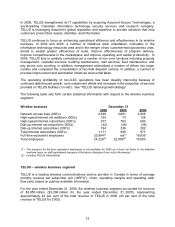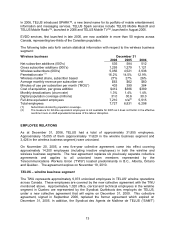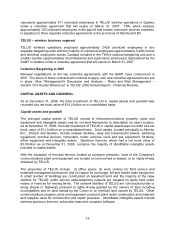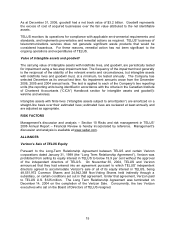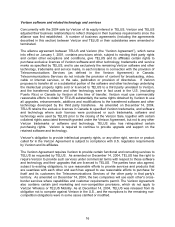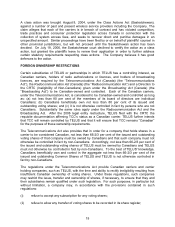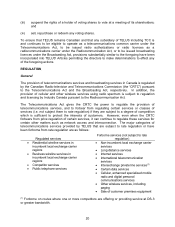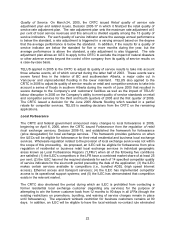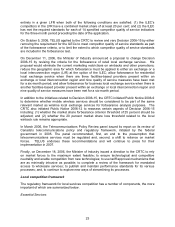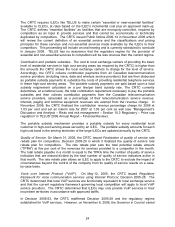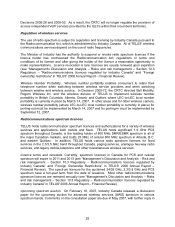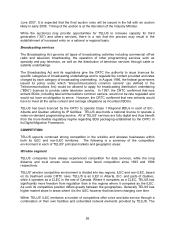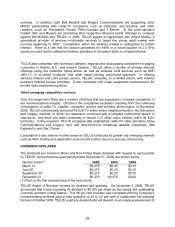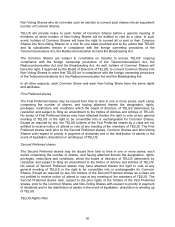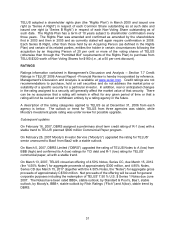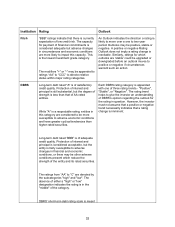Telus 2006 Annual Report Download - page 23
Download and view the complete annual report
Please find page 23 of the 2006 Telus annual report below. You can navigate through the pages in the report by either clicking on the pages listed below, or by using the keyword search tool below to find specific information within the annual report.Quality of Service. On March 24, 2005, the CRTC issued Retail quality of service rate
adjustment plan and related issues, Decision 2005-17 in which it finalized the retail quality of
service rate adjustment plan. The rate adjustment plan sets the maximum rate adjustment at 5
per cent of local service revenues and this amount is divided equally among the 13 quality of
service indicators. For each quality of service indicator where the average annual performance
is below the standard, a rate adjustment is triggered in a varying amount based on the degree
that the average performance is below the standard. In addition, if the results for a quality of
service indicator are below the standard for five or more months during the year, but the
average performance is above the standard, a rate adjustment is also triggered. The rate
adjustment plan allows an ILEC to apply to the CRTC to exclude the impact of natural disasters
or other adverse events beyond the control of the company from its quality of service results on
a case-by-case basis.
TELUS applied in 2005 to the CRTC to adjust its quality of service results to take into account
three adverse events, all of which occurred during the latter half of 2003. These events were
severe forest fires in the interior of BC and southwestern Alberta, a major cable cut in
Vancouver and unprecedented flooding in the lower mainland. TELUS also applied to the
CRTC in 2006 to adjust its quality of service results on retail and competitor services to take into
account a series of floods in southern Alberta during the month of June 2005 that resulted in
severe damage to the Company’s and customers’ facilities as well as the impact of TELUS’
labour disruption in 2005 on the Company’s ability to meet quality of service standards on retail
and competitor services for the third and fourth quarters of 2005 and the first quarter of 2006.
The CRTC issued a decision for the June 2005 Alberta flooding which resulted in a partial
rebate for competitor services. TELUS is awaiting decisions from the CRTC on the remaining
applications.
Local Forbearance
The CRTC and federal government announced many changes to local forbearance in 2006,
beginning on April 6, 2006, when the CRTC issued Forbearance from the regulation of retail
local exchange services, Decision 2006-15, and established the framework for forbearance
(price deregulation) for local exchange services. This framework provides guidance on when
the ILECs will be eligible for forbearance for their retail residential and business local exchange
services. Wholesale regulation related to the provision of local exchange service was not within
the scope of this proceeding. As proposed, an ILEC will be eligible for forbearance from price
regulation of residential or business retail local exchange services in individual geographic
areas known as Local Forbearance Regions (“LFRs”) when all of the following five conditions
are satisfied: (1) the ILEC’s competitors in the LFR have a combined market share of at least 25
per cent; (2) the ILEC has met the required standards for each of 14 specified competitor quality
of service indicators for the six-month period preceding the date of the application; (3) the ILEC
makes certain services available to competitors (i.e., bundled ADSL (high speed Internet
access), Ethernet access and transport services); (4) the ILEC has implemented competitor
access to its operational support systems; and (5) the ILEC has demonstrated that competition
exists in the relevant market.
The CRTC also shortened the period during which an ILEC is prohibited from contacting a
former residential local exchange customer (regarding any services) for the purpose of
attempting to win the former customer back from 12 months to 90 days in all LFRs (though the
existing restrictions on promotions, bundling, and waiving of service charges remain in place
until forbearance). The equivalent winback restriction for business customers remains at 90
days. In addition, an ILEC will be eligible to have the local winback no-contact rule eliminated
22


